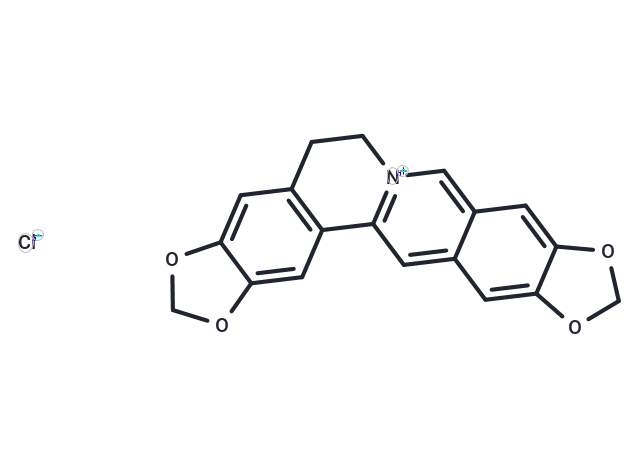Shopping Cart
- Remove All
 Your shopping cart is currently empty
Your shopping cart is currently empty

Pseudocoptisine chloride (Isocoptisine chloride) is isolated from Corydalis Tuber with anti-inflammatory and anti-amnestic properties. Pseudocoptisine chloride inhibits acetylcholinesterase (AChE) activity (IC50 = 12.8 μM).

| Pack Size | Price | Availability | Quantity |
|---|---|---|---|
| 1 mg | $67 | In Stock | |
| 5 mg | $163 | In Stock | |
| 10 mg | $247 | In Stock | |
| 25 mg | $463 | In Stock | |
| 50 mg | $683 | In Stock | |
| 100 mg | $967 | In Stock |
| Description | Pseudocoptisine chloride (Isocoptisine chloride) is isolated from Corydalis Tuber with anti-inflammatory and anti-amnestic properties. Pseudocoptisine chloride inhibits acetylcholinesterase (AChE) activity (IC50 = 12.8 μM). |
| Targets&IC50 | AChE:12.8 μM |
| In vitro | In RAW264.7 cells, Pseudocoptisine chloride (0, 60, 90 μM; 1 hour) inhibited LPS-induced NO production in a dose-dependent manner[1]. Pseudocoptisine chloride reduced levels of the pro-inflammatory mediators, such as, iNOS, COX-2, TNF-alpha, and IL-6 through the inhibition of NF-kappaB activation via the suppression of ERK and p38 phosphorylation. Pseudocoptisine chloride (30-90 μM; 1 hour) significantly reduced the LPS-induced TNF-α and IL-6 production and their mRNA expressions[2]. |
| In vivo | Pseudocoptisine chloride (2.0 mg/kg, p.o.) showed anti-amnesic activities on the learning and memory impairments induced by scopolamine (1.0 mg/kg, i.p.) and significantly reverses cognitive impairments in mice by passive avoidance test[2]. |
| Alias | Isocoptisine chloride |
| Molecular Weight | 355.77 |
| Formula | C19H14ClNO4 |
| Cas No. | 30044-78-1 |
| Smiles | [Cl-].C1Oc2cc3CC[n+]4cc5cc6OCOc6cc5cc4-c3cc2O1 |
| Relative Density. | no data available |
| Storage | Powder: -20°C for 3 years | In solvent: -80°C for 1 year | Shipping with blue ice. | ||||||||||
| Solubility Information | DMSO: 1 mg/mL (2.81 mM), Sonication and heating to 60℃ are recommended. | ||||||||||
Solution Preparation Table | |||||||||||
DMSO
| |||||||||||

Copyright © 2015-2024 TargetMol Chemicals Inc. All Rights Reserved.